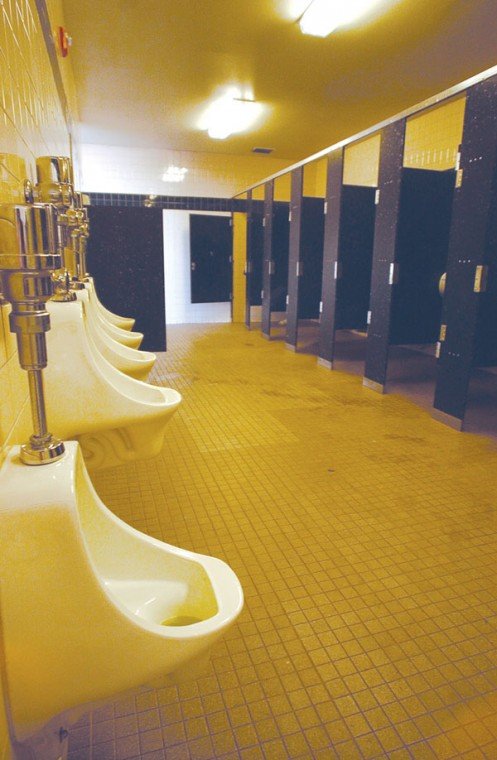GILROY
– Clean, safe school restroom facilities are the focus of a new
bill signed by Gov. Gray Davis, which tells school districts to
make restroom maintenance a priority. It is unclear what the impact
will be for Gilroy schools.
By Lori Stuenkel
GILROY – Clean, safe school restroom facilities are the focus of a new bill signed by Gov. Gray Davis, which tells school districts to make restroom maintenance a priority. It is unclear what the impact will be for Gilroy schools.
The bill requires school districts to prioritize deferred maintenance funding – normally reserved for major modifications and repairs such as painting or repairing asphalt – to ensure that restrooms are functional and meet basic hygiene standards.
Clean restrooms already are a priority in Gilroy, said district officials, who were unsure how deferred maintenance funds would be used under the new bill.
“Having clean schools is a priority and having clean bathrooms is a priority,” Superintendent Edwin Diaz said. “We’re anticipating we’ll get some guidelines from the state department defining what the requirements of the legislation are.”
Los Angeles Assemblyman Fabian Núñez, concerned with unsafe and filthy restrooms in the area, wrote the bill. School districts are required to maintain operational restrooms that are adequately stocked with supplies like soap, toilet paper and paper towels. It is unclear how the bill will be enforced.
Schools must use deferred maintenance funds if they cannot provide clean restrooms with general funds. The bill essentially gives school districts justification to dip into deferred maintenance funds if the restrooms are in particularly bad shape, encouraging districts to clean up their act, said Jeff Gopp, manager of maintenance and operations for GUSD. However, using those funds could take away from other projects.
“Most (Gilroy school restrooms) are in pretty good shape,” Gopp said. “It’s the daily cleanliness issue that’s the major concern for me.”
General restroom use is but a small part of the problem; vandalism is the biggest threat to restroom cleanliness.
“If we could just teach the kids not to vandalize the bathrooms, then we wouldn’t have a problem. We have just a total lack of respect by the students,” Director of Facilities and Maintenance Operations Charlie Van Meter said. “It’s not rampant, but we do run into those issues.”
In addition to general maintenance – which includes inspecting restrooms several times daily and re-stocking supplies as needed – custodians must tackle clogged toilets, urinals and sinks; graffiti; damaged soap and toilet paper dispensers; and foreign objects flushed down toilets. The culprits are probably a small percentage of students, Gopp said.
Maintaining cleanliness is usually a larger task at the middle schools and high school, which also have a larger student population than most elementary schools. A problem unique to elementary school restrooms, usually the boys’, is students using antibacterial soap to slide across the tile floor, Gopp said.
GUSD restroom maintenance was revisited by Gopp last year and this summer, partially in anticipation of the clean restroom bill. In October 2002, Gopp distributed a custodial handbook that provided specific, step-by-step cleaning instructions for school campuses, including restrooms, so facilities districtwide meet specific standards.
“It creates standards and makes sure everyone’s working under the same procedures,” Gopp said. “I have instructed all the daytime custodians to check, stock and clean the restrooms after recesses, lunch periods and at the end of the day, so at least three times a day.”
Hearing of the pending bill last spring, Gopp in June began concentrated inspections of each restroom in the district to identify fixtures like sinks or dispensers that needed to be replaced. Each restroom in the district, with the exception of those at South Valley Middle School, which are under construction, now contain push-button water faucets that automatically stop the flow of water, reducing students’ ability to clog and overflow sinks.
Since implementing the districtwide standards, Gopp said he has seen an improvement in restroom cleanliness throughout GUSD, particularly at Gilroy High School.
Students at the high school said cleanliness at all GHS restrooms improved when two new restrooms were installed in 2002.
“(The restrooms) have gotten a lot cleaner,” said Heather Dunmire, a junior.
Joe Yetter, also a junior, agreed that the restrooms have been better maintained the past two years.
“The whole floor used to be flooded in the guys’ bathroom a lot of the time,” he said. Yetter noted that students still make messes that custodians cannot always clean immediately. “In the guys’ bathroom, usually people clog up the sinks a lot and let the water run.”
Principal Bob Bravo said that, overall, the two daytime custodians at GHS keep restrooms clean and stocked, but they cannot survey all the restrooms all the time.
“Mostly, we’re trying to keep on top of them,” Bravo said. “It does come down usually to manpower and how many people you have to do the job.”
Bravo reflected other district officials’ confusion over how the state would enforce the new bill, since it does not provide additional funding for schools.
“It’s disappointing that it doesn’t come with extra money, but we want to do the best we can,” Bravo said. “I think it’s good to send that message to us. It should be what we want already, but I think it’s good to hear that extra message.”
Once the sink fixtures at South Valley are replaced, major work on GUSD restrooms will be complete, Gopp said. He was unsure whether the district would need to draw from deferred maintenance funds to pay for restroom maintenance.
“In my opinion, we can make (restrooms) workable and keep them clean … with what we have,” he said.














